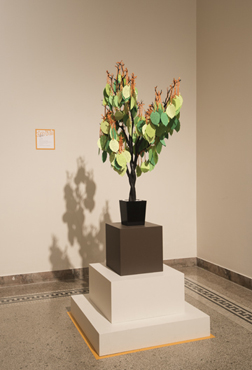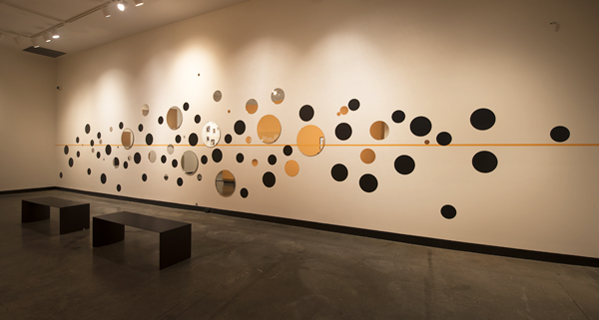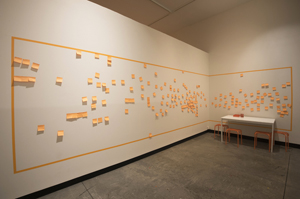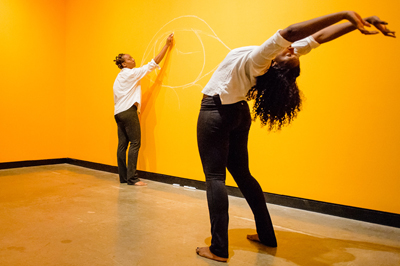Art Review: Do It-- Montclair, 2016: Arts Education and Community
By Christina Turczyn
arttimes online January 15, 2017
“I wish to be respected, loved, and rich in knowledge.”
-Anonymous Community Artist (Wish Piece)
The Montclair Art Museum, located in Montclair, New Jersey, is in the process of being remodeled, and offered an appropriate atmosphere for do it, a collaborative, international exhibit-in-process. The walls are white and orange—the space—open and minimalist. When I first walked in, I am immediately confronted by Chu Yun’s work Untitled (Q+A) (2007), which asks:
Question: “Does the notion of ‘do it’ indicate a proposal where no one can make mistakes?”
Answer: “You will only know after doing it.”
Immediately, I feel that I am in dialogue with the first gallery space I visit. I think of education, suggestion, and problem solving. I think about community playback theatre, which foregrounds issues that are high-stakes for any given time and place. I consider the ways in which people approach both joy and trauma, through images, just at the threshold of words. I think about creativity, even mistakes. I have always believed that mistakes are integral to individuals--that people err according to their own humanity, creating their errors in their own ways. Yet here, a better perspective inheres. No one can make mistakes, because the exhibit is open-ended, continuous; false criteria would suggest a hierarchy of interpretation, as would an aerial view without lived experience; do it is like life—you can only look back after testing the weather yourself. (And the weather is strong and unpredictable, since the exhibit embraces shifting, unmediated viewpoints.) Chu Yun’s answer suggests that as with living, no one should enter an artistic situation with preconceived ideas. But does the answer apply equally to love and war? Whatever the outcome, Chu Yun dares viewers to act, rather than to wait.
This exhibit works against passivity, encouraging the kind of active exploration and questioning that defines the most effective arts education. In the past several years, I have had the opportunity to work with many teaching artists, whom I believe to be some of the most creative educators sharing their expertise with others. Many of the artists with whom I spoke often enter potentially routine situations as newcomers with fresh approaches. I have always wondered whether, in addition to democratizing the arts, teaching artists give voice to students at the margins, whose stories, even cultures, may otherwise be suppressed. I am certain that artists who teach bring to educational settings the continuity of specific, cultural forms of knowing. In this way, they create intercultural, if not international understanding.
Arts education often heals through bridging the disciplines. Interdisciplinary work promotes change, as well as problem solving. When teaching artists search for novel approaches to their work, as well as share their singular perspectives, they demonstrate that there are multiple answers to a question. Just several of the artists featured in this exhibit include Yoko Ono, Felix Gonzalez-Torres, Hassan Sharif, and Amalia Pica. Art fosters leadership.
 Wish Piece (1996) Yoko Ono; Photo by Peter Jacobs/ Courtesy of Montclair Art Museum |
Wish Piece
Above, an anonymous community artist shares just one of the many wishes hung on Yoko Ono’s Wish Piece (1996) at the Montclair Art Museum. Most of the collective works remain intentionally unsigned, and will be destroyed at the end of this site’s enactment. The process of beginning anew with each interpretive context keeps the work from becoming static. The directions for this specific work were: “Make a wish. Write it down on a piece of paper. Fold it and tie it around a branch of a Wish Tree. Ask your friends to do the same. Keep wishing. Until the branches are covered with wishes.” The exhibit seems to begin with desire, although one interpretation of the Wish Piece is apparent in its name. In times when individuals can be so isolated, do it, which originated as the brainchild of Hans-Ulrich Obrist, as well as of the artists Christian Boltanski and Bertrand Lavier, is one of the longest-running traveling exhibitions in art history. According to Independent Curators International, since 1993, when the originators created the concept, exhibits have taken place in fifty countries, while the original directions have been translated into nine languages. Celebrating its 20th year, the exhibit encourages innovative education, engages the community, and brings vital local, national, and international issues to the fore. Catherine Mastrangelo, Assistant Director of Marketing and Communications at the museum, added: “One part I find fascinating is that when the show opened in 1993, there were no social media, while we've added a regular social media component. Each Monday we post an artist instruction to our Facebook, Twitter, and Instagram and encourage folks to DO IT at home and SHARE IT—something that would not have been possible to a great extent when the show was originated.” The exhibit, which highlights 27 works from among 250, runs from September 10 to December 31, 2016.
Leah Fox, Director of the Vance Wall Education Center, together with Gail Stavitsky, Chief MAM Curator, served as the coordinators of this event. In fact, the Education Center first opened in the spring of 2016 as a space that extends the museum’s educational outreach. The Yard School of Art offers courses in multiple media. Spacious galleries offer ongoing opportunities for interaction. (Schools visit the museum in the hours before it opens to the public.) The museum’s focus is on contemporary and traditional Native American art stemming from diverse nations, as well as American art from the 18th century to the present. The show lives up to the original artists’ vision: “Do it is a call to action.” In Sarah Ko and Laurie Lim’s video of the same name, members of the original team also describe the exhibit as a “score of scores.” When experiencing the range of artistic contributions, I do not think of a game; I think about a light clock with a beat.
And walking around the museum is a musical experience, as the exhibit can be viewed from different angles. Sol LeWitt’s “black, not straight line…” (2001) might be a chord. (Interpreted by three Montclair University M.F.A. students, this piece seems to be at the epicenter of the exhibit). Next to the wall, on the floor, is the Alison Knowles-inspired installation, Homage to Each Red Thing (1996). Like a quilt or a frame, the exhibition space is divided into squares, each of which contains a red object. Standing objects create a three-dimensional dissonance when contrasted with intersecting lines. Virtually nothing in the exhibit is solely two-dimensional or contained. Every piece emerges from existing limitations, even as it calls attention to them. Do it subverts exoticization. Homage to Each Red Thing is an installation that houses a “For Rent” sign, among numerous pieces, along with a text titled How to Cook Everything. A pair of boxer’s gloves rest in one square. In an adjacent room, a painting in chalk, like skywriting, remains after the dance piece, Instruction.
 Beauty Marks (2004) Hreinn Fridfinnssen Courtesy of Montclair Art Museum |
Beauty Marks
Several of the instructional works that engaged young peoples’ creativity are Beauty Marks (2004), by Hreinn Fridfinnsson, Do It Yourself (For Children, 2011) by the Raqs Media Collective and Les Ecoliers (The Schoolchildren, 1993) by Christian Boltanski. The first, interpreted by the Girl Scouts and Montclair Art Museum ART teen digital photography students, led to a discussion of diverse concepts of beauty moderated by the COPE Center of Montclair. Since beauty is all too readily defined in Western tradition as thin and passive, Beauty Marks offers infinite alternatives: We, the viewers, can look at opaque circles placed alongside round mirrors, where we regard ourselves as—beautiful? The constant conversation between the “mirrors on the wall,” and passersby elides static representation. (One of the dancers in Instruction steps forward out of the body image that she has drawn). Constantly moving, gallery visitors are not objectified through the immobile representation of men or women as models. Instead, their faces are alive, imperfect, shimmering.
In my opinion, innovative arts education brings critical issues into discussion, and takes learning out of traditional spaces. Young artists, as well as adults, bring to light their most compelling concerns. They become active creators of their own lives.
 DO IT YOURSELF (for children) (2011) RAQS Media Collective; Photo by Peter Jacobs/ Courtesy of Montclair Art Museum |
Do It Yourself
Do It Yourself seems to collapse ideas into dense words. Reading the titles of “books that you would like all children to read and enjoy,” I think about Freud’s Interpretation of Dreams. In his concept of the rebus are images that collide, inspire. Perhaps it is the power of words or objects, taken out of linear context to evoke, rather than define, that allows meanings to resonate through association. The instructions for book titles, devised by the Raqs Media Collective, encourage participants to “imagine and invent five titles of books that [they] would like all children to read and enjoy. “Remember,” the instructions note, “these books don’t exist.” “No one has written them, yet. By making up names for them, [visitors] are helping them appear in the world.”
Several unusual titles include They Will Learn of the War Room, as well as Flowers Love to Dance. Other titles, which could potentially become a concrete poem, are What Matters; Kids—Golden Treasure: Adults—Keep Dreaming, 50 Shades of Orange, and Be Here Today. There is testimony (I Survived Life after a Car Crash) and admonition (No Racist U.S.A.) Political and election concerns, at times, figure prominently as themes. This part of the exhibit encourages an intergenerational dynamic, where the voices of adults and youth emerge side by side on small, orange pieces of paper. We, the viewers, are challenged to supply the rest of the text. Because we cannot do that right away-- we keep on reading with interest. Viewers are asked to bring these texts, conceptually, into the world. And the collective works of art in this exhibit accomplish that. They take ideas and move them beyond any one person into non-traditional spaces. The directions are starting points for artistic communities worldwide, which continue their conversations online. One might consider this event as one akin to Poetry in Motion, which takes poems into the transit systems of cities.
Work in the Montclair Art Museum was initiated in different locations, across time, by numerous organizations. Gail Stavitsky described the exhibit as “really a combination of performance art, conceptual art and interactive art. The ideas for the art began with the artists. The execution, the making of the art, is delegated to us – the audience.”
 Instruction (2002) Joan Jonas; Dancers Titilayo Dericotte and Tiara Knox, with music by Roderick Jackson Photo by Gennadi Novash/Courtesy of Montclair Art Museum |
Instruction
Contemporary voices and concerns emerge strongly in this iteration. An extremely compelling piece that initiated the exhibit is a dance performance titled Instruction, by Tiara Knox, Titilayo Dericotte, and Roderick Jackson, after the original instructions by Joan Jonas (2002). The directions read: “Dance with a large piece of chalk. Mark up the nearest surface and pay attention to the movement of your feet. Music optional.” I cannot help but contextualize the chalk outline of one dancer’s body, drawn against a wall’s surface. With her back touching the wall, the dancer draws a semi-circle—then, an outline of herself. The half-circle might suggest time, partly erased, as she leans towards one side. When I see the artist’s body outlined, I think of Ferguson. I think of Dallas. I think of victims lying on the ground when the dancer draws a star near the figure’s heart. Is it the mark that a bullet made? Is it a badge? Is there time left to act? The dancer moves away from the form she has marked. As a viewer, I am empowered by the abstract lines of the piece created, as well as by the power of the dance, the power that breaks through any conceptual framework the viewer wishes to assign. The abstract form behind the dancers allows me to connect to the piece through my own experience, yet my own experience is only a projection. I have often thought about wordless traumas—traumas so deep beneath the level of consciouness that their images must gradually seek language or other forms of understanding. I cannot speak for the dancers’ interpretation. I can only think of movement and memory, cultural tradition and innovation, sadness as well as celebration. How the dance summons the entire exhibit to it through its depth.
Roderick Jackson’s drums pull participants into the space. I am reminded of the present by his music. I am made aware of seconds. How will I take action? How will I remember? How will I see?
Adrian Piper’s Humming Room (2012) raises, in my mind, the same question of witness. A uniformed guard stands before the door of a room. “In order to enter the room, you must hum a tune. Any tune will do,” the instructions inform. There are three dates listed under the piece: Which ones will museum visitors choose—to hum? Is the piece playful or is it a command? Does it speak to survival? Recollection? The tune does not seem to matter, as long as the viewer, wishing to enter what might be a confining space, provides what is necessary. This piece is, I believe, a stark commentary upon the forms of freedom participants give up, in order to enter intricately guarded lives of their own creation.
Before I leave, I return to Yoko Ono’s sculpture. I look at the pieces of paper onto which wishes are written by museum visitors. “I wish I could help all my family in need.” “I wish for world peace.” “I wish to be a mermaid.” “…I wish I still lived in my country with my best friend.” “…to be great at drums.” “Family, health, and happiness.” “I wish I could have a donut.” Personally, I wish that all education could be like this. That local communities should speak. That international communities should be heard. That children should release the latest news onto a lawn, in the form of a ball of papers soaked in water, unafraid. In the end, do it approximates the many languages of rain, multi-syllabic and asynchronous. The exhibit is a world phenomenon without any easily packaged universals or cultural appropriations. It is both an invitation and a warning.
Art should be this visceral. Education should be this moving. Adults should take such artistic risks.
The words of Paolo Freire, quoted in the introduction to Teachers as Cultural Workers: Letters to Those Who Dare Teach, echo the dialogue begun here:
We must dare, in order to say scientifically...that we study, we learn, we teach, with our entire body. We do all of these things with feeling, with emotion, with wishes, with fears, with doubts, with passion, and also with critical reasoning. However, we never study, learn, teach, or know with the last only. We must dare so as to never dichotomize cognition and emotion...We must dare to learn how to dare in order to say no to the bureaucratization of the mind to which we are exposed every day. We must dare that we can continue to do so, even when it is so much more materially advantageous to stop daring (ix).
Christina Lilian Turczyn, a visual artist and writer, lives in Bergen County, NJ
